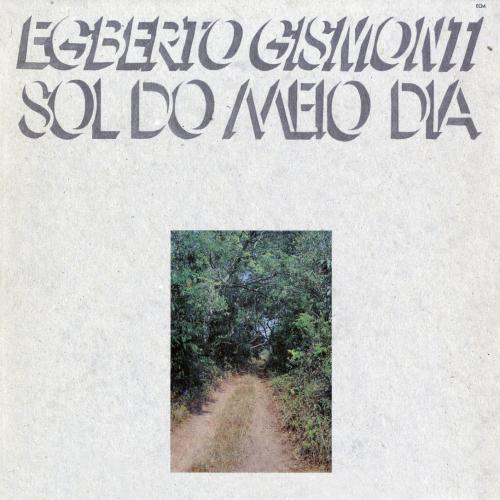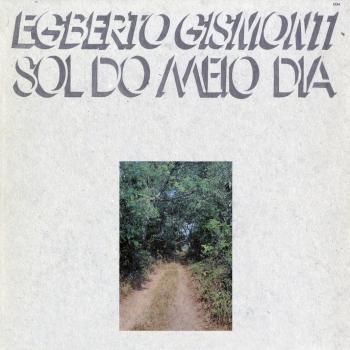
Sol Do Meio Dia (2023 Remaster) Egberto Gismonti
Album info
Album-Release:
1978
HRA-Release:
21.07.2023
Album including Album cover
I`m sorry!
Dear HIGHRESAUDIO Visitor,
due to territorial constraints and also different releases dates in each country you currently can`t purchase this album. We are updating our release dates twice a week. So, please feel free to check from time-to-time, if the album is available for your country.
We suggest, that you bookmark the album and use our Short List function.
Thank you for your understanding and patience.
Yours sincerely, HIGHRESAUDIO
- 1 Palácio De Pinturas 05:33
- 2 Raga 08:48
- 3 Kalimba (Lua Cheia) 05:14
- 4 Coração 05:58
- 5 Café - Sapain - Dança Solitária No.2 - Baiao Malandro 24:50
Info for Sol Do Meio Dia (2023 Remaster)
On this 1978 album, the Brazilian guitarist Egberto Gismonti is accompanied by his frequent collaborator on percussion, Nana Vasconcelos, as well as Ralph Towner, Collin Walcott and Jan Garbarek – all of them being or having been ECM stalwarts. The album is inspired by Egberto’s time spent with the Xingu of the Amazon, to whom the album is dedicated.
“This album is a classic, no doubt about it.” (Jazziz)
"After his 1976 debut on ECM, the stunning Danca Das Cabecas with percussionist Naná Vasconcelos, Gismonti returned the following year with this impressive combo outing. Actually, the album consists of a mix of solo pieces and cuts with various partners, in both duo and trio formats. He penned all the material and shines throughout. The guest do the same, with special mention going to guitarist Ralph Towner, percussionist Colin Walcott, tenor saxophonist Jan Garbarek, and Vasconcelos. Highly recommended." (Stephen Cook, AMG)
Egberto Gismonti, 8-string guitar, kalimba, piano, wood flutes, voice, bottle
Naná Vasconcelos, percussion, berimbau, tama, corpo, voice, bottle (tracks 2, 3 & 5)
Ralph Towner, 12 string guitar (tracks 1 & 5)
Collin Walcott, tabla, bottle (track 2)
Jan Garbarek, soprano saxophone (track 5)
Recorded November 1977 at Talent Studio in Oslo, Norway
Produced by Manfred Eicher
Digitally remastered by Christoph Stickel
Egberto Gismonti
is world-renowned as a multi-instrumentalist and composer. He was profoundly influenced by Brazilian master Heitor Villa-Lobos, his works reflecting the musical diversity of Brazil. From the Amazon Indians' batuque to the Carioca samba and choro, through the Northeastern frevo, baião, and forró, Gismonti captures the true essence of the Brazilian soul in a way that is primitive, yet sophisticated, and reflects it through his personal vision, elaborated by years of classic training and literacy in a wealth of musical languages in which jazz plays a significant role.
From a musical family, in which his grandfather and his uncle Edgar were bandleaders, he started to take piano and theory classes at five. At that time, he also started to learn the flute and the clarinet, eventually taking the violão (acoustic guitar) in his teens. Following the piano classical tradition because of his father, he embraced the guitar to please his Italian mother, who was very fond of serenatas. Trying to transpose the piano's polyphonic quality for the guitar, he spent several years developing three custom-made instruments (ten-, 12-, and 14-stringed) and developed his own two-hand technique. At eight, he started to study piano with Brazilian masters Jacques Klein and Aurélio Silveira, with whom he would remain for 15 years. He subsequently moved to Nova Friburgo, a small town near Rio, for one year and four months and attended the Nova Friburgo Music Conservatory. At age 20, he refused a classical music scholarship in Vienna to delve deeper into popular music. In October 1968, Os Três Morais performed his composition "O Sonho," arranged for a 100-piece orchestra, at the third International Song Festival (FIC), which was aired by TV Globo in Rio.
This song, with its uncanny orchestration, provoked enthusiasm around and was recorded 18 different times by several international artists. Soon after, he left Brazil for France, where he became the conductor and orchestrator for the French singer Marie Laforêt in an association that lasted for nearly two years. It was instrumental for him to meet and became a pupil of the great masters Jean Barraqué (1928-1973), a disciple of Anton Webern, and Nadia Boulanger (1887-1979), a former consultant to Igor Stravinsky. The importance of these two icons was to not only underscore the unique richness of his country's background, but also to urge him to pursue a singular expression rooted in the cabocla and mestiça traditions.
His first LP, Egberto Gismonti (Elenco) was released in 1969 and featured his vocals on original compositions and those of bossa nova composer Paulo Sérgio Vale. That same year, he performed at the San Remo Festival in Italy. In 1970, he toured through Europe, recording two singles in France, one LP in Italy, one in Brazil (Sonho 70), and one LP in Germany (Orfeu Novo). His song "Mercador de Serpentes" was presented at the fifth FIC. Returning to Brazil in 1971, he settled in Teresópolis, another small town close to Rio. That year he played in several venues in Brazil, and his music was incorporated into the soundtracks of the movies A Penúltima Donzela (Fernando Amaral, 1969), Confissões de Frei Abóbora (Brás Chediak, 1971), and Em Família (Paulo Porto, 1971).
In 1972, he recorded Água e Vinho, in partnership with poet Geraldo Carneiro, and in 1973, Egberto Gismonti and Academia de Danças (EMI/Odeon), the latter of which was the turning point when he began to stress his instrumental work. After recording, the producer said it made no sense at all. He received a note from EMI/Odeon saying that, due to Brazil's economic difficulties, that would be the last album of Gismonti's career: it was an album outside of any category, with 25-minute tracks, expensively produced with synths and orchestra. This album was awarded with the Golden Record in Brazil.
From 1972 to 1991, Gismonti recorded 19 albums for EMI/Odeon. In 1974, he accepted an invitation to play at a festival in Berlin, Germany, and asked Hermeto Pascoal and Naná Vasconcelos to join him. He then met ECM's CEO, Manfred Eicher. Returning to Brazil, he received a letter from ECM inviting him to record with them. Not knowing what would be the importance of that label, he postponed the response until the end of 1976. Then he accepted the invitation, imagining he'd record with the all-star Brazilian group he was performing with by then: drummer/percussionist Robertinho Silva, bassist Luis Alves, and saxophonist/flutist Nivaldo Ornelas, but the Brazilian military government had imposed a high fee for all leaving Brazilians at about 7,000 dollars, so he decided to record solo. Fearing that challenge, he was wandering through Norway when he encountered a friend, a Brazilian actor, who invited him to his home, where he met Brazilian percussionist Naná Vasconcelos. With the three-day time constraint, he decided to involve Vasconcelos and, when asked to describe the album's concept, he explained that both performers had a common history: two boys wandering through a dense, humid forest, full of insects and animals, keeping a 180-foot distance from each other. He knew Vasconcelos would accept without hesitation. His LP Dança das Cabeças with Vasconcelos received several contradictory international awards reflecting Brazilian cultural richness: in England, it was awarded as a pop record; in the U.S., as folk music; in Germany, as classical music. Either way, it changed both artists' lives: Vasconcelos immediately became an international artist, touring worldwide; Gismonti returned to Brazil and decided to research Amazon folklore. In the heart of the Amazon forest, Alto Xingu, he tried to make contact with the Yawaiapitì tribe, playing his flute for two weeks until head chief Sapaim invited him to his home. They shared no common language other than music, and Gismonti spent about a month living and learning with them, upon the condition of spreading the forest people's values. Two years later, with saxophonist Jan Garbarek, percussionist Colin Walcott, and guitarist Ralph Towner, he recorded Sol do Meio-Dia. His LP Solo, released that next year, sold 100,000 copies in the U.S. In 1981, with Garbarek and bassist Charlie Haden, he recorded the LP Magico. The same year, the trio toured Europe, including a concert at the Berlin Jazz Festival, and recorded a second Magico album, entitled Folksongs. In 1981, Gismonti toured again with Haden and Garbarek, performing throughout Europe. Also in that year, he recorded the double album Sanfona with his all-star group Academia de Danças (drummer Nenê, saxophonist/flutist Mauro Senise, and bassist Zeca Assunção). With Vasconcelos, he recorded Duas Vozes in 1985. In 1989, he recorded Dança dos Escravos and in 1990, following the release of Dança das Cabeças, Gismonti toured the United States with his group, which included cellist Jaquinho Morelembaum, flutist/saxophonist Nivaldo Ornellas, and keyboardist Edu Mello E Souza.
Also in 1990, he recorded Infância, accompanied by Nando Carneiro (guitar/keyboards), Zeca Assumpção (bass), and cellist Jaquinho Morelembaum. With the same group, he recorded Música de Sobrevivência in 1993, an album inspired by the writings of the Brazilian poet Manoel de Barros, who reflects in his work the Brazilian duality of the cultivated Portuguese tradition and the massive illiteracy disseminated in that country, which, notwithstanding, deeply influences the official language. In 1995, he recorded Meeting Point with the State Symphonic Orchestra of Lithuania. In 1996, Gismonti recorded Zig Zag with Nando Carneiro and Zeca Assumpção. He also owns the successful label Carmo, which has several joint ventures with ECM. He recently performed an almost impossible task: He bought the rights for all of his scores through EMI/Odeon for worldwide publishing, with the exception of Brazil. However, music continues to be his main focus. In 2009, Gismonti released the two-disc Saudacoes, which featured one disc of his seven-part composition, "Sertões Veredas —Tributo à Miscigenação," and a second disc of guitar duets with his son Alexandre Gismonti.
This album contains no booklet.









